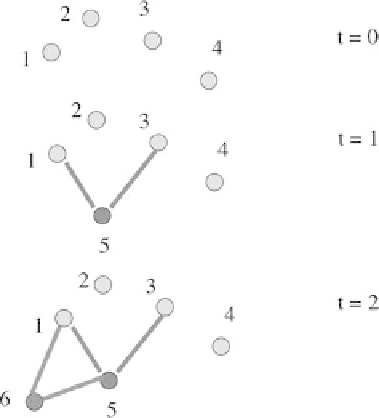Information Technology Reference
In-Depth Information
Figure 6.2.
This graph illustrates how the BA model works. At time
t
=
0 the network consists of four
nodes with no link. At time
t
=
1 the new node 5 arrives with two links. The new node selects
randomly two of the four nodes already present in the network, in this case nodes 1 and 3. At
time
t
=
2 the new node 6 arrives and selects two of the five nodes already present in the
environment. Node 5 has already two links. Thus the new node selects it, with one of its two
links. The nodes 1 and 3 have one link, whereas nodes 2 and 4 do not have any. Thus, node 6
may select either node 1 or node 3 with equal probability. In this case it selects node 1.
new element is made at random. The choice of the next
m
nodes is not completely
random, but is carried out by selecting with higher probability the elements that have
the larger number of previously existing links; see, for example, a geometric sketch of
this argument in Figure
6.2
.
At a given integer time
t
we have
N
nodes, with
m
0
playing the role of the initial state
of the web,
N
(
t
)
=
m
0
+
t
,
(6.2)
with
K
edges,
K
(
t
)
=
mt
.
(6.3)
Note that at any time step the number of edges per node increases by 2
m
. In fact, any
new edge arriving increases by one the number of links of an element already belonging
to the network, and brings an additional link for the newly arriving node. Thus, the total
number of connections at any time is given by
=
,
k
j
2
mt
(6.4)
j
where
k
j
is the number of links to the
j
th element at time
t
.
The time rate of change in the number of links to the
j
th element at time
t
is given by
dk
j
dt
=
m
(
k
j
),
(6.5)


